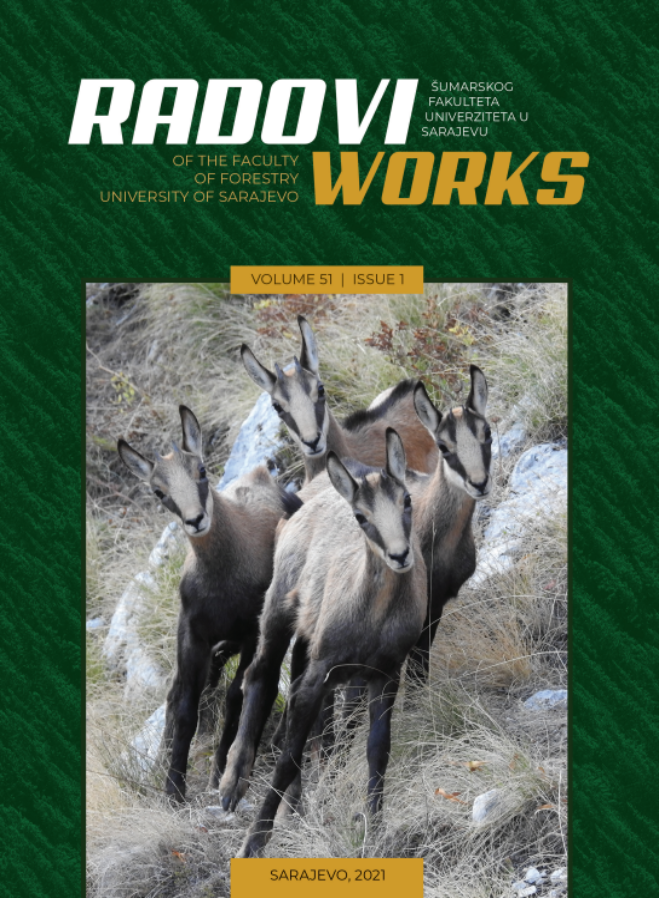Spatial structure – case study on experimental plots of beech (Fagus sylvatica L.) and scots pine (Pinus sylvestrisL.) in Olovo, Bosnia and Herzegovina
DOI:
https://doi.org/10.54652/rsf.2021.v51.i1.351Abstract
Spatial structure is the horizontal and vertical arrangement of individual trees. It affects many processes in the stand such as stability, production and regeneration. Stand structure parameters are used to describe spatial structure on experimental plots. The paper presents methods that describe the stand structure through three levels of diversity related to position, species and size. Research has been conducted on two experimental plots from the area of Olovo. Referent trees and their competitors were selected on both experimental plots, and competitors were defined by referent tree distance. The aim of this paper is to describe the spatial structure on experimental plot of European beech (Fagus sylvatica L.) and experimental plot of European beech and Scots pine (Pinus sylvestris L.). Indicators of spatial diversity, dimensional diversity and diversity of tree species have been determined to achieve that aim. For each experimental plots are described: horizontal tree distribution (Poisson Distribution, Clapham's Variance – Mean Ratio and Morisita's Index of Dispersion), diameter differentiation (Diameter Differentiation by Füldner and Dominance Index by Hui et al.), species diversity and structural diversity (Species Profile Index by Pretzsch) and species intermingling (Species Intermingling Index by Füldner). Obtained results show that the stand structure of both experimental plots deviates from random distribution. Dimensional diversity parameters indicate stronger intensity of competition for beech trees. Analysis of species diversity showed that beech trees occur in groups or patches, and the other represented species mix more intensive.
References
Avdagić, A., Mattioli, W., Balic, B., Ivojevic, S., Pastorella, F. (2014) Field Map, an innovative tool for data collection in forestry and landscape architecture-description, functionality and use. Naše Šume, Vol.13 No.36/37 pp. 30-34
Begon, M., Harper, J., & Townsend, C. (1986). Ecology. Oxford: Blackwell Science.
Bella, I. (1971). A new competition model for individual trees. Forest Science, 17(3), 364-372
Brand, D. G., & Magnussen, S. (1988). Asymmetric, two-sided competition in even-aged monocultures of red pine. Canadian Journal of Forest Research, 18, 901-910
Burkhart, H. E., & Tomè, M. (2012). Modeling Forest Trees and Stands. Indices of individual-tree competition. Netherlands: Springer Science and Business Media. 201-228
Dirnberger, G., Sterba, H., Condés, S. et al. (2017).. Species proportions by area in mixtures of Scots pine (Pinus sylvestris L.) and European beech (Fagus sylvatica L.). Eur J Forest Res 136, 171–183. https://doi.org/10.1007/s10342-016-1017-0
Ford, E., & Sorrensen, K. (1992). Theory and models of inter-plant competition as a spatial process. (D. DeAngelis, & L. Gross, Eds.) Chapman and Hall, 363-407
Gadow, K., & Hui, G. (1998). Modelling forest development. Individual tree growth. Germany: Faculty of Forest and Woodland Ecology, University of Göttingen. 129-142
Gadow, K., & Hui, G. (2001). Characterizing forest spatial structure and diversity. Georg-August-University Göttingen, Institute of Forest Management.
Heym, M., Ruíz-Peinado, R., Del Río, M., Bielak, K., Forrester, D.I., Dirnberger, G., Barbeito, I., Brazaitis, G., Ruškytkė, I., Coll, L., Fabrika, M., Drössler, L., Löf, M., Sterba, H., Hurt, V., Kurylyak, V., Lombardi, F., Stojanović, D., Ouden, J.D., Motta, R., Pach, M., Skrzyszewski, J., Ponette, Q., de Streel, G., Sramek, V., Čihák, T., Zlatanov, T.T., Avdagic, A., Ammer, C., Verheyen, K., Włodzimierz, B., Bravo-Oviedo A. & Pretzsch, H. (2017). EuMIXFOR empirical forest mensuration and ring width data from pure and mixed stands of Scots pine (Pinus sylvestris L.) and European beech (Fagus sylvatica L.) through Europe. Annals of Forest Science 74, 63 https://doi.org/10.1007/s13595-017-0660-z
Li, Y., Hui, G., Wang, H., Zhang, G., & Ye, S. (2017). Selection priority for harvested trees according to stand structural. iForest Biogeosciences and forestry, 10, 561-566.
Liu, J., & Burkhart, H. E. (1994). Modeling Inter- and Intra-specific Competition in Loblolly Pine (Pinus taeda L.) Plantations on Cutover, Site-prepared lands. Annals of Botany, 73, 429-435
Pommerening, A. (2002). Approaches to quantifying forest struczures. Forestry: An International Journal of Forest Research, 75(3), 305-324
Pretzsch, H. (2009). Forest Dynamics, Growth and Yield. Berlin: Springer. 223-336
Pretzsch, H., del Río, M., Ammer, Ch., Avdagic, A., Barbeito, I., Bielak, K., Brazaitis, G., Coll, L., Dirnberger, G., Drössler, L., Fabrika, M., Forrester, D.I., Godvod, K., Heym, M., Hurt, V., Kurylyak, V., Löf, M., Lombardi, F., Matović, B., Mohren, F., Motta, R., den Ouden, J., Pach, M., Ponette, Q., Schütze, G., Schweig, J., Skrzyszewski, J., Sramek, V., Sterba, H., Stojanović, D., Svoboda, M., Vanhellemont, M., Verheyen, K., Wellhausen, K., Zlatanov T & A. Bravo-Oviedo. (2015) Growth and yield of mixed versus pure stands of Scots pine (Pinus sylvestris L.) and European beech (Fagus sylvatica L.) analysed along a productivity gradient through Europe. Eur J Forest Res 134, 927–947. https://doi.org/10.1007/s10342-015-0900-4
Pretzsch, H., del Rio, M., Schutze, G., Ammer, C., Annighofer, P., Avdagic A., Barbeito, I., Bielak, K., Brazaitis, G., Coll, L., Droessler, L., Fabrika, M., Forrester, D.I., Kurylyak, V., Lof, M., Lombardi, F., Matovic, B., Mohren, F., Motta, R., den Ouden, J., Pach, M., Ponette, Q., Skrzyszewski, J., Sramek, V., Sterba, H., Svoboda, M., Verheyen, K., Zlatanov, T., Bravo-Oviedo, A. (2016). Mixing of Scots pine (Pinus sylvestris L.) and European beech (Fagus sylvatica L.) enhances structural heterogeneity, and the effect increases with water availability, Forest Ecology and Management, Volume 373, 2016, Pages 149-166. ISSN 0378-1127. https://doi.org/10.1016/j.foreco.2016.04.043
Staudhammer, C. L., & LeMay, V. M. (2001). Introduction and evaluation of possible indices of stand structural diversity. Canadian Journal of Forest Research, 31(7), 1105-1115
Tomè, M., & Burkhart, H. E. (1989). Distance-Dependent Competition Measures for Predicting Growth of Individual Trees. Forest Science, 35, 816-831
Weiskittel, A. R., Hann, D. W., Kershaw, J. A., & Vanclay, J. K. (2011). Forest Growth and Yield Modeling. Indices of competition. Chichester, West Sussex: John Wiley & Sons, Ltd. 15-35.
Šumskogospodarska osnova za "Olovsko" šumskogospodarsko područje. Period važnosti od 01.01.2012. do 31.12.2021. godine.



















